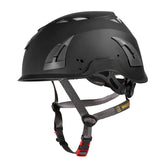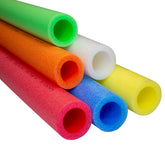Unsurprisingly, working at height is widely deemed as one of the most dangerous on-site activities. This also means it’s one of the leading causes of injuries and deaths on site.
Working at height exposes workers to a variety of risks, from falls from height to being struck by falling objects. Recent figures from the Health and Safety Executive confirm the threat, with a reported increase in deaths within the construction industry over the last year. Falls from height accounted for almost one third of fatal injuries.
The focus on any scaffolding or construction project must be to keep workers safe first and foremost. Safety relies on tradespersons using the most appropriate PPE for the task at hand. But with such a range of PPE to choose from it can be difficult to decipher the safety helmet you need, or which harness will most likely cut the mustard with the site safety officer.
In this guide, we discuss what key factors should be considered when selecting PPE for working at height.
-
#1 Review the scenario – what PPE do you need?
Before you start work on a project and decide on the most suitable PPE, it’s important to conduct a thorough risk assessment. You and your team must have a crystal-clear understanding of the potential hazards that could be encountered to help decide what height safety PPE will provide the best protection.
The hierarchy of control plays an essential role here. Firstly, consideration should be given to restraint so we can prevent a fall from occurring in the first place. Then, thoughts should turn to work positioning PPE to aid the positioning and support of the worker at height. Finally, consideration should be given to fall arrest PPE in order to arrest the worker in the event a fall does occur.
-
#2 Consider size and fit
You need to keep your workers safe. Comfort is critical to this.
The first concern is of course that poorly fitted equipment could render any safety equipment you use redundant, especially if it means the worker doesn’t want to wear or use it. Furthermore, if it’s uncomfortable for the wearer, that’s likely to reduce their productivity. Any PPE should allow employees to carry out their duties with a full range of motion and without causing difficulty.
PPE isn’t always one-size-fits-all. Always consider the best fit for you and your team.
-
#3 Does your PPE deliver best-in-class protection?
Of course, the most important factor is whether or not the safety equipment does what it says on the tin. When working at height is required during a project, keeping tradespersons safe should always be the top priority. Make sure you carry out thorough research to make certain you’re purchasing the best equipment available. Is it innovative? Is it market leading? Is it best in class? Would you be happy wearing it? These are questions you must consider before making a final decision.
-
#4 Do you have confidence in the manufacturer?
We hate to sound dramatic, but lives are at stake.
Suppliers and manufacturers build up their reputations by delivering excellent products and services over long periods of time. So, when searching for height safety equipment, be sure to check if your supplier has a trusted reputation of delivering market-leading height safety solutions, and that they have the evidence to back it up. You need to be confident you’re choosing PPE and height safety equipment that does the job you need it to.
-
#5 Regulatory compliance
Having the necessary awareness of all the relevant legislation and regulations that exist to mitigate against any risks is vital.
For example, when working at height, you will need to comply with the Work at Height Regulations 2005. These regulations apply to an employer or if you control work at height (contractor or factory owner), and stipulate that any work at height must be properly planned, supervised, and carried out by competent people with measures in place to protect everyone at risk.
Overarching regulations such as this have done a tremendous job of improving the culture of safety within the scaffolding and construction industries more generally. But this isn’t the only regulation you should look out for...
Much of the equipment used must also now meet a certain standard to guarantee the best protection. Take safety helmets as an example. By choosing a helmet that complies with the EN397 standard, you can have increased confidence workers have the best protection against falling objects. Equipment that meets specific standards go through rigorous testing to ensure we’re doing as much as possible to prevent injuries.
-
#6 Don’t get caught out on price
Finally, it’s easy to get caught out by equipment when the price tag tempts, but we believe there are two risks attached to this procurement approach.
- It may break., and you could find yourself making many repeat purchases which will cost you more in the long run
- If it does break, buying more equipment might be the least of your concerns. What if a member of your team was injured in the process?
Always balance cost with delivering the best safety for you and your team.
Let’s make working at height safer
Working at height is clearly dangerous. But those business that excel at implementing stringent safety measures, and who choose the most appropriate PPE, will be successful in reducing the risk of injuries to workers. Explore Leach’s range of quality PPE and height safety equipment now, or contact our sales team on 01432 346890 for further guidance.


















